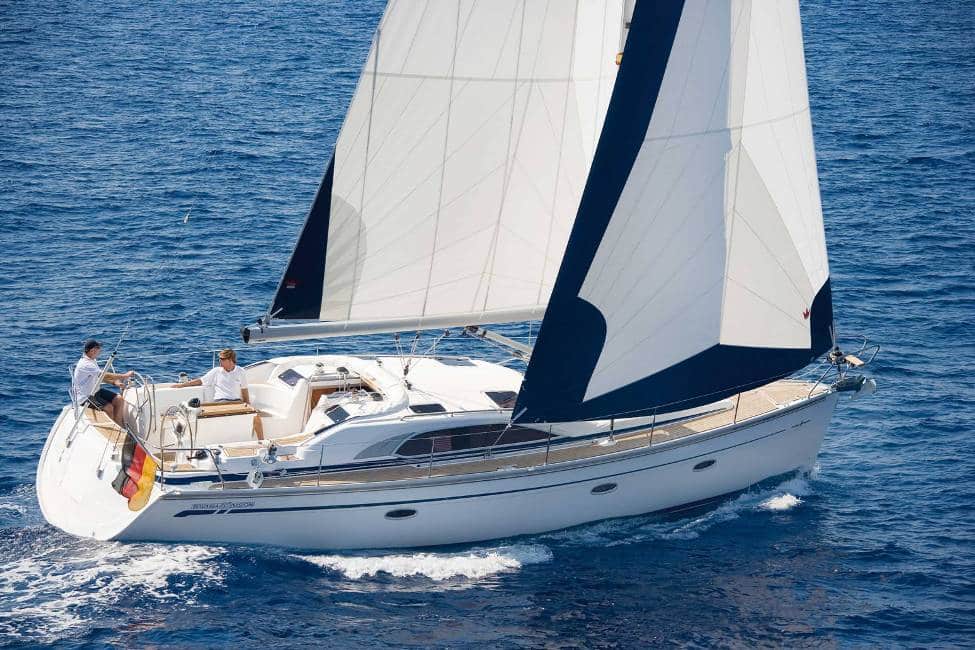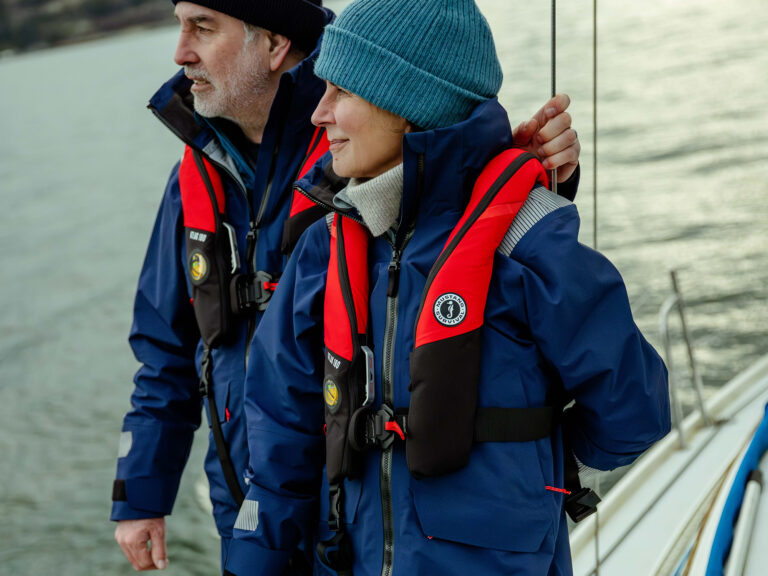
Bavaria Yachts has stepped out with a pair of guns blazing in its hunt for sailors in the upscale part of the cruiser market. Last summer, the German sailboat manufacturer launched the first boats in its new Vision Series, a 40- and a 44-footer, aiming squarely at the deck-saloon offerings of such rivals as Jeanneau, Etap, and Hunter. (So far, only the 40 Vision has made a hop stateside, making its American debut last fall.)
Based on plans drawn by longtime Bavaria collaborator J&J Yacht Design of Slovenia, the 40 Vision and 44 Vision feature beefed-up sail plans, modest-draft and deep-keel options, and performance hulls wrapped around loads of space for comfortable surroundings below. A 50-foot version is also in the works.
Moored side by side against a quay just outside the offices of Yates Alemanes, Bavaria’s largest dealer, in Palma de Mallorca, the 40 and 44 looked virtually identical to me: Both have relatively low coach roofs, cat’s-eye ports, beamy hulls, the telltale Bavaria blue stripe along the coachroof, and teak decks. Both offer stern boarding via a swim platform, twin Lewmar wheels, molded-in teak-topped cockpit tables, and fold-down, recessed dodgers. Both have fractional Seldén rigs with in-mast furling (also available in a conventional rig), Seldén Rodkicker vangs, mast-mounted spinnaker poles, Elvström Sobstad sails, Furlex roller furlers, and single bow rollers that feed chain out of lockers equipped with Lewmar windlasses.
And that’s the point. When J&J sets out to design a new Bavaria, the company has two goals: optimize performance and optimize manufacturing. In simple terms, that means make the same gear work across multiple models so Bavaria can buy in bulk and keep prices down. Bavaria doors, fold-up companionway steps (for engine access), and cockpit lockers all use the same hinges. Saloon tables are interchangeable, with the 40’s table also designed to fit the Bavaria 37 Cruiser. Volvo engines and saildrives are delivered from the factory in one piece so a lone worker can slip each into place and secure it with eight bolts threaded through computer-cut holes in the boat’s laminated-in integral grid.
When I stepped below I began to see what 4 feet in length means in interior volume. On the 44, you feel as though you can stretch out a bit in the slightly larger saloon and certainly in the forward cabin. Two steps on either side of the V-berth queen offer easy access and flank two large storage drawers under. There’s a small bench seat to starboard with a double hanging locker over; to port is an enclosed head with a foldout shower enclosure. The 40 also serves up a queen berth forward, but without the forward head, and with two smaller lockers on either side of the cabin.
Aft of the main bulkhead, each boat has a large dining table to port with a bench seat amidships that provides a solid handhold while moving forward. To starboard, the 44 has two chairs separated by a table, while the 40 offers a perhaps more practical settee that could be used by a not-too-tall crew for napping. Aft of these are forward-facing nav stations with fiddled desktops, room below for a few paper charts, and ample space to install the electronics of an owner’s choosing.
At the foot of the companionway, both boats have heads with showers to starboard and quite workable galleys to port. Outboard in each are a two-burner propane stove and oven and a 12-volt refrigeration-equipped ice chest. Forward in the L-shaped galleys there are stainless-steel double sinks with front-opening refrigerators. Countertops are Corian with tall, rounded fiddles.
Farther aft are double cabins, each with hanging lockers; thick, comfortable-looking mattresses; and opening ports.
In the saloon of each boat, cabin-top hatches are covered by shades to help cut heat from the sun; blinds over the deck-saloon ports are recessed behind plywood trim that runs the length of the cabin. While handholds are ample throughout the saloon, this trim board is placed in a way that presents a tempting handhold in a seaway, especially in the galley, and I think its heft would be insufficient to support someone grabbing it. I’d also like to have seen a sealer applied to the ends of floorboards.
It’s worth noting that the Visions are at the upper end of the price range at this segment of the market, so more attention to detail and finish might be expected.
On deck, differences between the two Visions emerge, as well, particularly in the cockpit, where the size of the 44 allows for wide coamings that are easy to step up on when headed forward. On the 40, these are narrower, with steps that provide a less secure foothold. Stainless-steel grabrails are found on either side of the cabin top, and with chainplates located inboard, wide side decks make for a worry-free trip forward while under way.
And under way is where you’ll enjoy being.
Heading out of the harbor toward Badia de Palma, the 40 Vision, powered up by its 40-horsepower Volvo diesel and saildrive (a 55-horsepower is optional; the 44 comes standard with a 55-horsepower and an optional 75-horsepower Volvo) accelerated quickly to nearly 8 knots at 2,600 rpms, according to the onboard GPS, and backed well after an initial bout of starboard prop walk.
As we rounded the breakwater into about 8 to 10 knots of breeze, out rolled the sails and we were off, the boat heeling modestly and cutting smoothly through the light chop.
On this day, we had the benefit of the sailmaker’s presence aboard the 40 to tweak, trim, and keep us on pace with the 44. The Vision 40 tacked easily through 100 degrees, and we sailed along at just over 6 knots in about 9 knots of true wind. The boat comes equipped with Raymarine ST 60 Tridata and wind instruments. The chart plotter (mounted at the end of the cockpit table) and autopilot are options.
Cracking off, we continued to hold our own against the 44. Relaxing at the leeward helm station, I took my hand off the wheel for a moment, and then another moment, and then several more. On a reach, this boat just dug in and sailed straight, without need of a helmsman until it was time to tack.
After an hour and a half of enjoyable sailing, it was time to luff up and jump across to the bigger Vision. It, too, moved along at 6.7 knots in about 9 knots of true wind, and I couldn’t help but notice that it was tough to pull away from the nearby 40. Maybe it was that sailmaker?
At the dock, it occurred to this American observer that back home, a Bavaria is a relatively rare sight (Bavaria Yachts USA hopes to import 130 a year), but here, smack-dab in the middle of the Med, they’re everywhere. And indeed, that perception is true. Bavaria makes 3,200-plus boats a year, and now it has two more in its line with which to woo the Yanks.
Bavaria 40 Vision Specs
LOA: 41′ 8″ (12.7 m.)
LWL: 34′ 9″ (10.6 m.)
Beam: 13′ 1″ (3.99 m.)
Draft: 5′ 9″ (1.75 m.)
Sail Area (100%): 822 sq. ft. (76.4 sq. m.)
Displacement: 18,081 lb. (8,200 kg.)
Water: 95 gal. (210 l.)
Fuel: 55 gal. (55 l.)
Engine: 40-hp. Volvo w/ saildrive
Designer: J & J Yacht Design
Price: $236,000
Mark Pillsbury is Cruising World’s senior editor.








